Contemporary Childhoods 700289: Analysis of Screen Technology's Impact
VerifiedAdded on 2022/09/07
|7
|1550
|23
Report
AI Summary
This report examines the impact of screen technology on young children, analyzing a media article and related research. The analysis explores both the positive and negative effects of screen time, including its influence on cognitive development, language skills, and social-emotional well-being. The report discusses how excessive screen use can lead to delays in literacy, hinder social interaction, and potentially contribute to issues like impulsivity and sleep problems. The study also considers the role of parental behavior, the limitations of technology, and the child's environment in shaping their attitude towards technology. The report references academic sources and an annotated bibliography to support its findings, highlighting the importance of understanding the complex relationship between screen technology and childhood development.
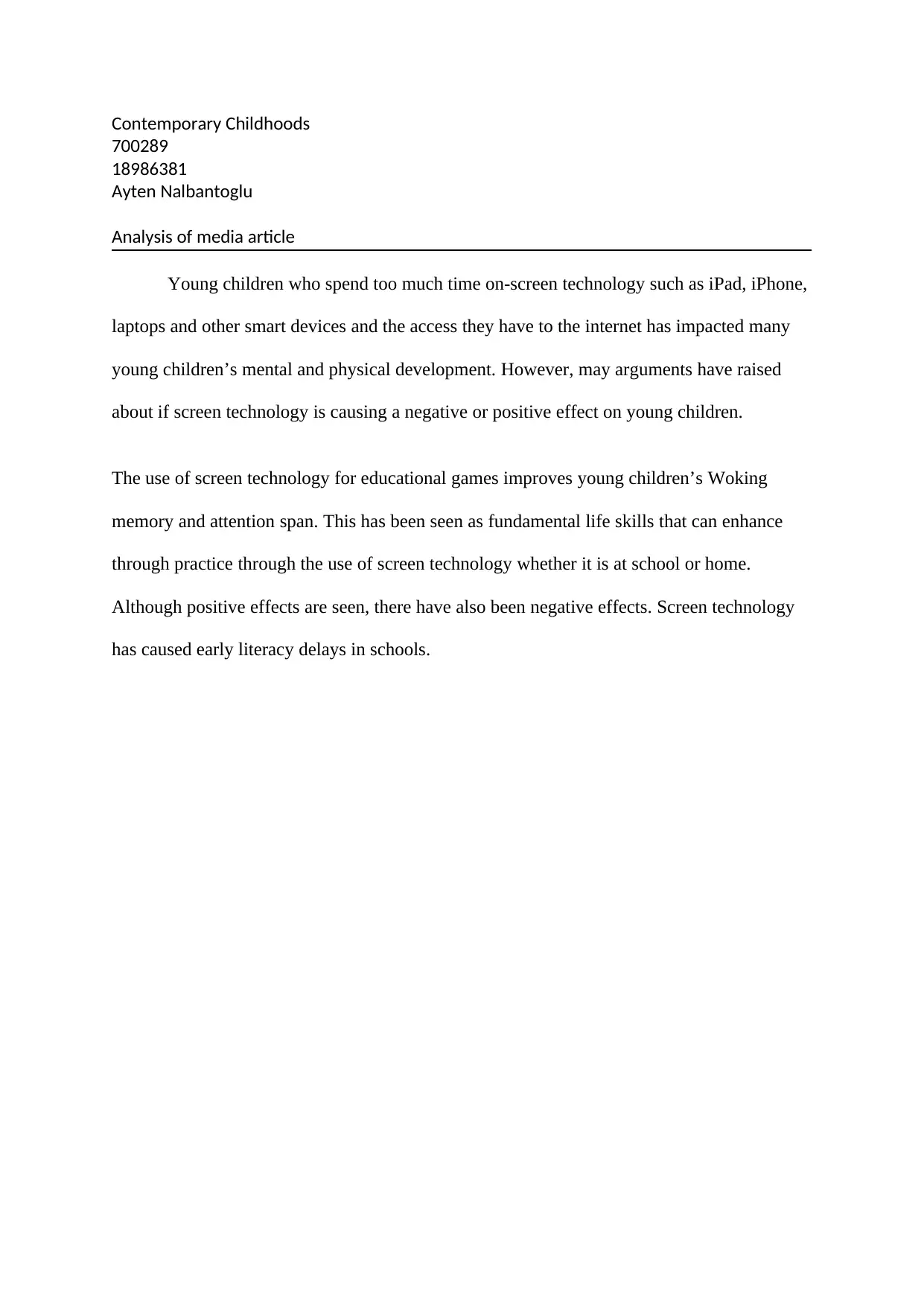
Contemporary Childhoods
700289
18986381
Ayten Nalbantoglu
Analysis of media article
Young children who spend too much time on-screen technology such as iPad, iPhone,
laptops and other smart devices and the access they have to the internet has impacted many
young children’s mental and physical development. However, may arguments have raised
about if screen technology is causing a negative or positive effect on young children.
The use of screen technology for educational games improves young children’s Woking
memory and attention span. This has been seen as fundamental life skills that can enhance
through practice through the use of screen technology whether it is at school or home.
Although positive effects are seen, there have also been negative effects. Screen technology
has caused early literacy delays in schools.
700289
18986381
Ayten Nalbantoglu
Analysis of media article
Young children who spend too much time on-screen technology such as iPad, iPhone,
laptops and other smart devices and the access they have to the internet has impacted many
young children’s mental and physical development. However, may arguments have raised
about if screen technology is causing a negative or positive effect on young children.
The use of screen technology for educational games improves young children’s Woking
memory and attention span. This has been seen as fundamental life skills that can enhance
through practice through the use of screen technology whether it is at school or home.
Although positive effects are seen, there have also been negative effects. Screen technology
has caused early literacy delays in schools.
Paraphrase This Document
Need a fresh take? Get an instant paraphrase of this document with our AI Paraphraser
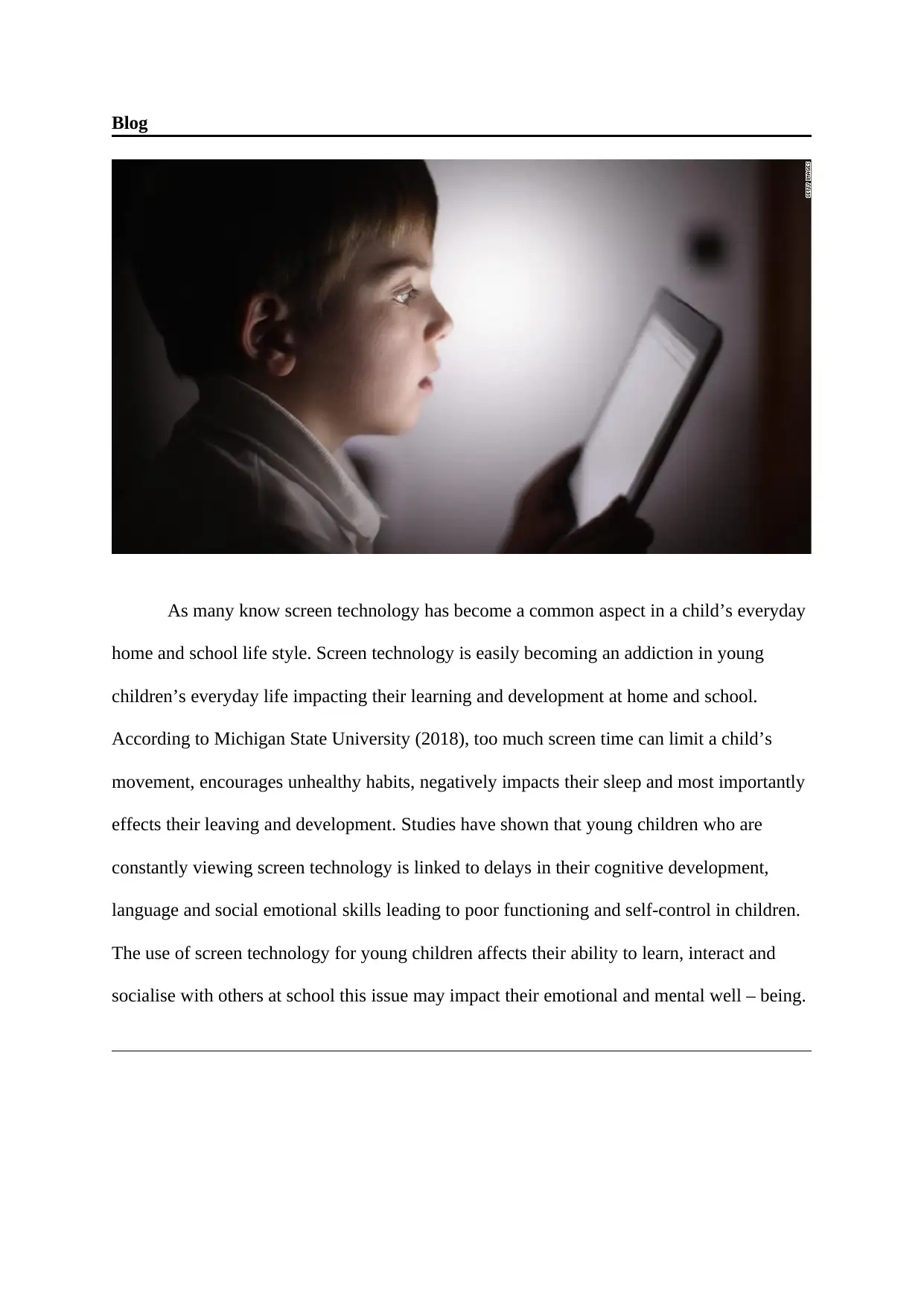
Blog
As many know screen technology has become a common aspect in a child’s everyday
home and school life style. Screen technology is easily becoming an addiction in young
children’s everyday life impacting their learning and development at home and school.
According to Michigan State University (2018), too much screen time can limit a child’s
movement, encourages unhealthy habits, negatively impacts their sleep and most importantly
effects their leaving and development. Studies have shown that young children who are
constantly viewing screen technology is linked to delays in their cognitive development,
language and social emotional skills leading to poor functioning and self-control in children.
The use of screen technology for young children affects their ability to learn, interact and
socialise with others at school this issue may impact their emotional and mental well – being.
As many know screen technology has become a common aspect in a child’s everyday
home and school life style. Screen technology is easily becoming an addiction in young
children’s everyday life impacting their learning and development at home and school.
According to Michigan State University (2018), too much screen time can limit a child’s
movement, encourages unhealthy habits, negatively impacts their sleep and most importantly
effects their leaving and development. Studies have shown that young children who are
constantly viewing screen technology is linked to delays in their cognitive development,
language and social emotional skills leading to poor functioning and self-control in children.
The use of screen technology for young children affects their ability to learn, interact and
socialise with others at school this issue may impact their emotional and mental well – being.
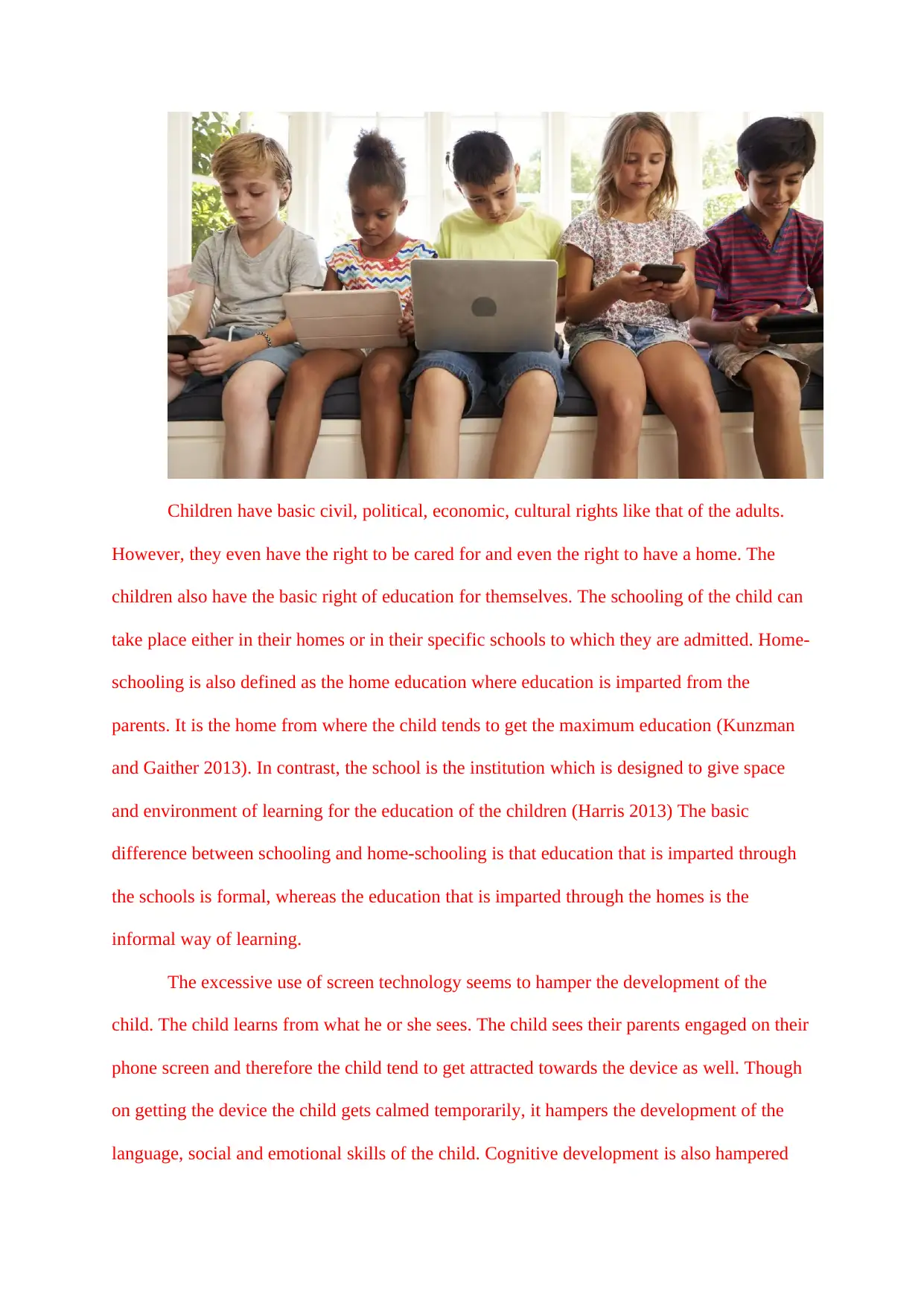
Children have basic civil, political, economic, cultural rights like that of the adults.
However, they even have the right to be cared for and even the right to have a home. The
children also have the basic right of education for themselves. The schooling of the child can
take place either in their homes or in their specific schools to which they are admitted. Home-
schooling is also defined as the home education where education is imparted from the
parents. It is the home from where the child tends to get the maximum education (Kunzman
and Gaither 2013). In contrast, the school is the institution which is designed to give space
and environment of learning for the education of the children (Harris 2013) The basic
difference between schooling and home-schooling is that education that is imparted through
the schools is formal, whereas the education that is imparted through the homes is the
informal way of learning.
The excessive use of screen technology seems to hamper the development of the
child. The child learns from what he or she sees. The child sees their parents engaged on their
phone screen and therefore the child tend to get attracted towards the device as well. Though
on getting the device the child gets calmed temporarily, it hampers the development of the
language, social and emotional skills of the child. Cognitive development is also hampered
However, they even have the right to be cared for and even the right to have a home. The
children also have the basic right of education for themselves. The schooling of the child can
take place either in their homes or in their specific schools to which they are admitted. Home-
schooling is also defined as the home education where education is imparted from the
parents. It is the home from where the child tends to get the maximum education (Kunzman
and Gaither 2013). In contrast, the school is the institution which is designed to give space
and environment of learning for the education of the children (Harris 2013) The basic
difference between schooling and home-schooling is that education that is imparted through
the schools is formal, whereas the education that is imparted through the homes is the
informal way of learning.
The excessive use of screen technology seems to hamper the development of the
child. The child learns from what he or she sees. The child sees their parents engaged on their
phone screen and therefore the child tend to get attracted towards the device as well. Though
on getting the device the child gets calmed temporarily, it hampers the development of the
language, social and emotional skills of the child. Cognitive development is also hampered
⊘ This is a preview!⊘
Do you want full access?
Subscribe today to unlock all pages.

Trusted by 1+ million students worldwide
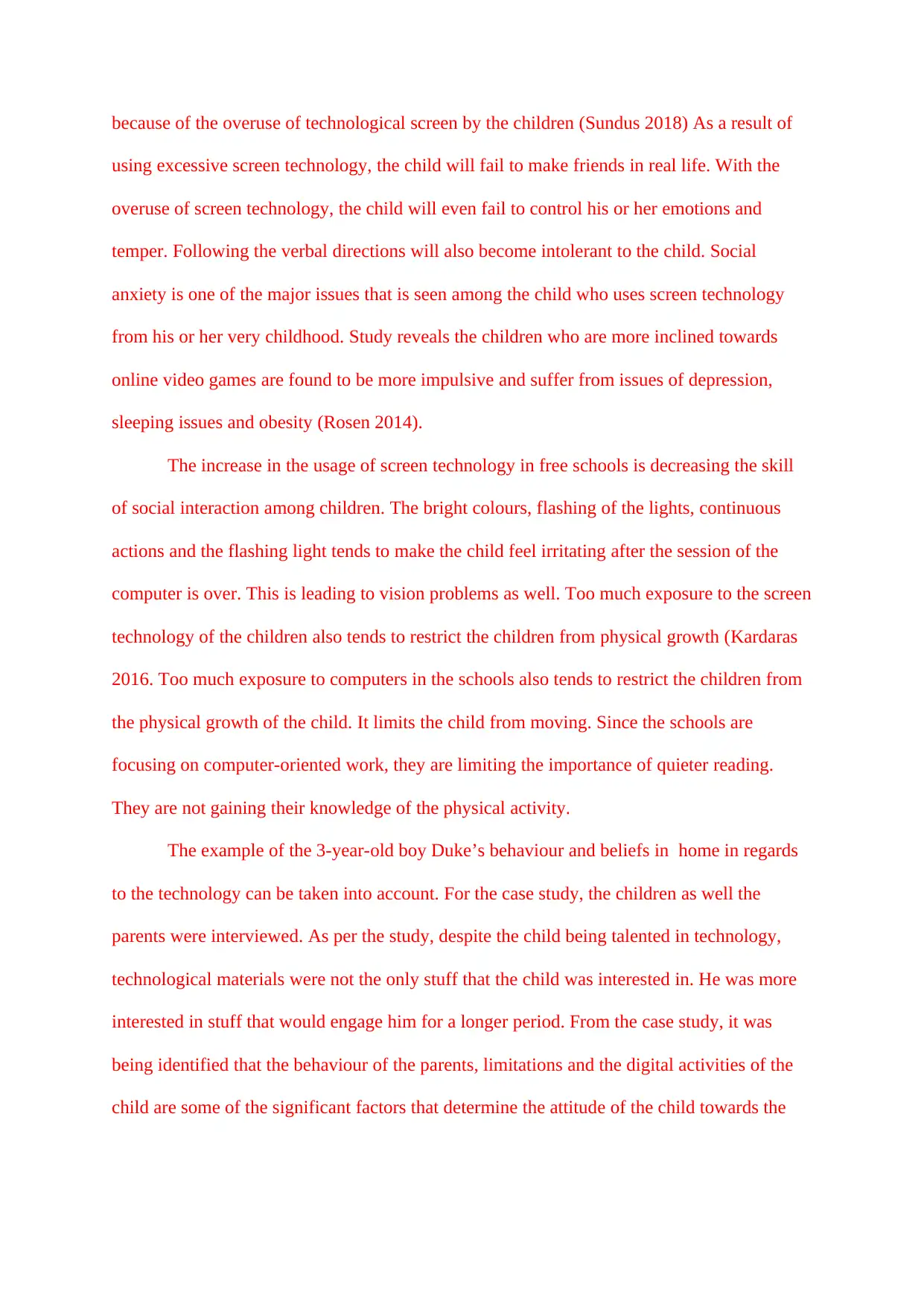
because of the overuse of technological screen by the children (Sundus 2018) As a result of
using excessive screen technology, the child will fail to make friends in real life. With the
overuse of screen technology, the child will even fail to control his or her emotions and
temper. Following the verbal directions will also become intolerant to the child. Social
anxiety is one of the major issues that is seen among the child who uses screen technology
from his or her very childhood. Study reveals the children who are more inclined towards
online video games are found to be more impulsive and suffer from issues of depression,
sleeping issues and obesity (Rosen 2014).
The increase in the usage of screen technology in free schools is decreasing the skill
of social interaction among children. The bright colours, flashing of the lights, continuous
actions and the flashing light tends to make the child feel irritating after the session of the
computer is over. This is leading to vision problems as well. Too much exposure to the screen
technology of the children also tends to restrict the children from physical growth (Kardaras
2016. Too much exposure to computers in the schools also tends to restrict the children from
the physical growth of the child. It limits the child from moving. Since the schools are
focusing on computer-oriented work, they are limiting the importance of quieter reading.
They are not gaining their knowledge of the physical activity.
The example of the 3-year-old boy Duke’s behaviour and beliefs in home in regards
to the technology can be taken into account. For the case study, the children as well the
parents were interviewed. As per the study, despite the child being talented in technology,
technological materials were not the only stuff that the child was interested in. He was more
interested in stuff that would engage him for a longer period. From the case study, it was
being identified that the behaviour of the parents, limitations and the digital activities of the
child are some of the significant factors that determine the attitude of the child towards the
using excessive screen technology, the child will fail to make friends in real life. With the
overuse of screen technology, the child will even fail to control his or her emotions and
temper. Following the verbal directions will also become intolerant to the child. Social
anxiety is one of the major issues that is seen among the child who uses screen technology
from his or her very childhood. Study reveals the children who are more inclined towards
online video games are found to be more impulsive and suffer from issues of depression,
sleeping issues and obesity (Rosen 2014).
The increase in the usage of screen technology in free schools is decreasing the skill
of social interaction among children. The bright colours, flashing of the lights, continuous
actions and the flashing light tends to make the child feel irritating after the session of the
computer is over. This is leading to vision problems as well. Too much exposure to the screen
technology of the children also tends to restrict the children from physical growth (Kardaras
2016. Too much exposure to computers in the schools also tends to restrict the children from
the physical growth of the child. It limits the child from moving. Since the schools are
focusing on computer-oriented work, they are limiting the importance of quieter reading.
They are not gaining their knowledge of the physical activity.
The example of the 3-year-old boy Duke’s behaviour and beliefs in home in regards
to the technology can be taken into account. For the case study, the children as well the
parents were interviewed. As per the study, despite the child being talented in technology,
technological materials were not the only stuff that the child was interested in. He was more
interested in stuff that would engage him for a longer period. From the case study, it was
being identified that the behaviour of the parents, limitations and the digital activities of the
child are some of the significant factors that determine the attitude of the child towards the
Paraphrase This Document
Need a fresh take? Get an instant paraphrase of this document with our AI Paraphraser
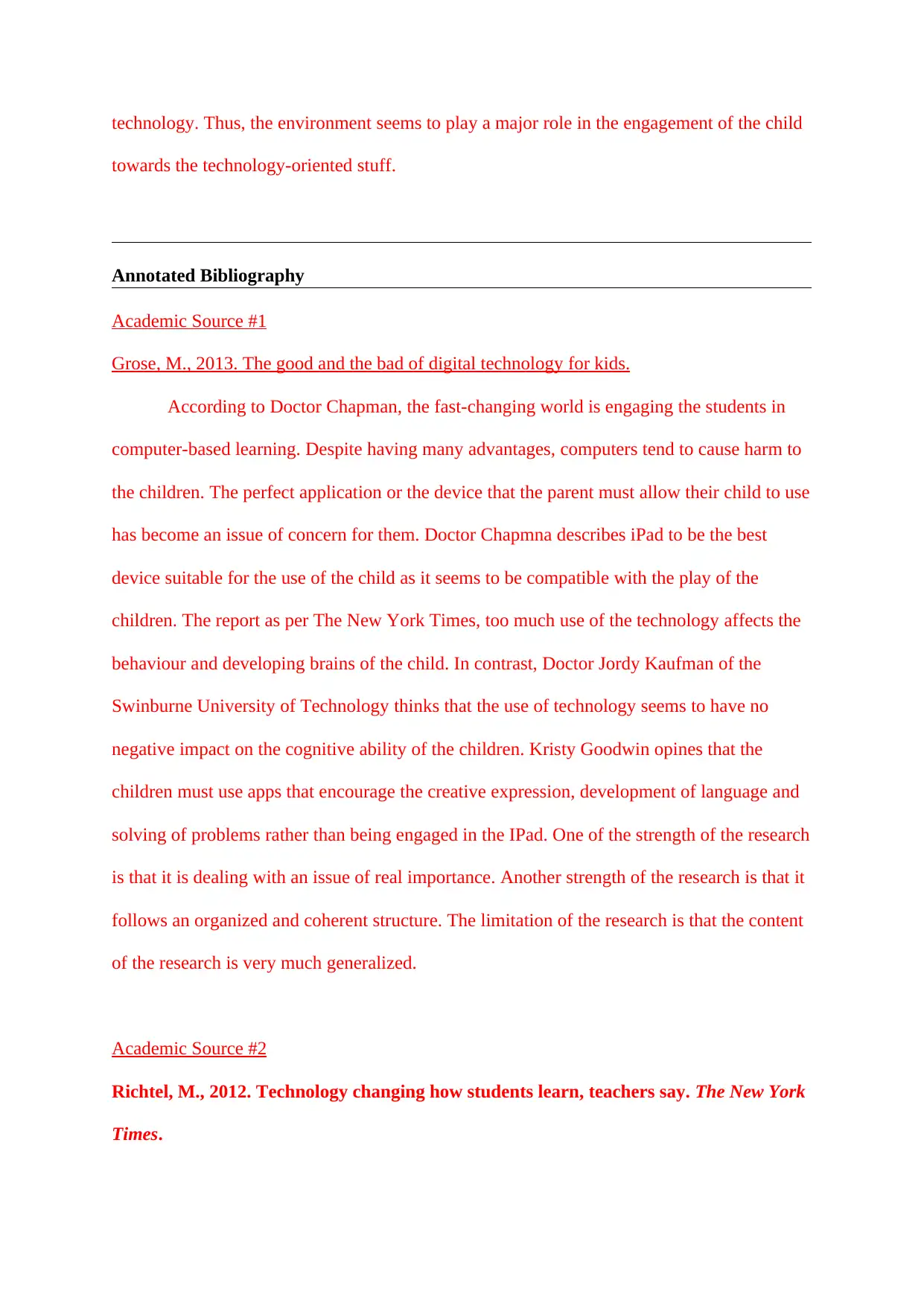
technology. Thus, the environment seems to play a major role in the engagement of the child
towards the technology-oriented stuff.
Annotated Bibliography
Academic Source #1
Grose, M., 2013. The good and the bad of digital technology for kids.
According to Doctor Chapman, the fast-changing world is engaging the students in
computer-based learning. Despite having many advantages, computers tend to cause harm to
the children. The perfect application or the device that the parent must allow their child to use
has become an issue of concern for them. Doctor Chapmna describes iPad to be the best
device suitable for the use of the child as it seems to be compatible with the play of the
children. The report as per The New York Times, too much use of the technology affects the
behaviour and developing brains of the child. In contrast, Doctor Jordy Kaufman of the
Swinburne University of Technology thinks that the use of technology seems to have no
negative impact on the cognitive ability of the children. Kristy Goodwin opines that the
children must use apps that encourage the creative expression, development of language and
solving of problems rather than being engaged in the IPad. One of the strength of the research
is that it is dealing with an issue of real importance. Another strength of the research is that it
follows an organized and coherent structure. The limitation of the research is that the content
of the research is very much generalized.
Academic Source #2
Richtel, M., 2012. Technology changing how students learn, teachers say. The New York
Times.
towards the technology-oriented stuff.
Annotated Bibliography
Academic Source #1
Grose, M., 2013. The good and the bad of digital technology for kids.
According to Doctor Chapman, the fast-changing world is engaging the students in
computer-based learning. Despite having many advantages, computers tend to cause harm to
the children. The perfect application or the device that the parent must allow their child to use
has become an issue of concern for them. Doctor Chapmna describes iPad to be the best
device suitable for the use of the child as it seems to be compatible with the play of the
children. The report as per The New York Times, too much use of the technology affects the
behaviour and developing brains of the child. In contrast, Doctor Jordy Kaufman of the
Swinburne University of Technology thinks that the use of technology seems to have no
negative impact on the cognitive ability of the children. Kristy Goodwin opines that the
children must use apps that encourage the creative expression, development of language and
solving of problems rather than being engaged in the IPad. One of the strength of the research
is that it is dealing with an issue of real importance. Another strength of the research is that it
follows an organized and coherent structure. The limitation of the research is that the content
of the research is very much generalized.
Academic Source #2
Richtel, M., 2012. Technology changing how students learn, teachers say. The New York
Times.
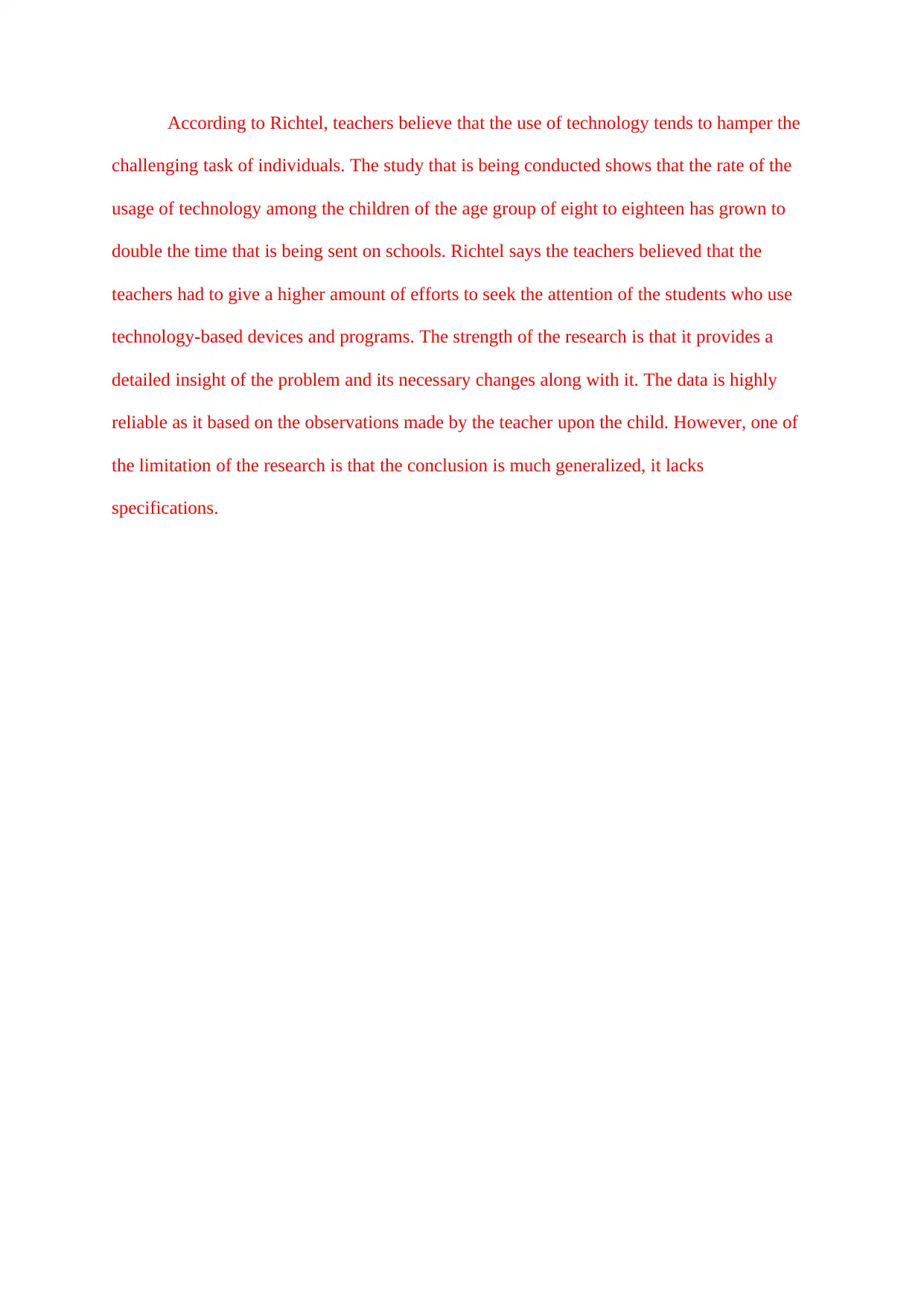
According to Richtel, teachers believe that the use of technology tends to hamper the
challenging task of individuals. The study that is being conducted shows that the rate of the
usage of technology among the children of the age group of eight to eighteen has grown to
double the time that is being sent on schools. Richtel says the teachers believed that the
teachers had to give a higher amount of efforts to seek the attention of the students who use
technology-based devices and programs. The strength of the research is that it provides a
detailed insight of the problem and its necessary changes along with it. The data is highly
reliable as it based on the observations made by the teacher upon the child. However, one of
the limitation of the research is that the conclusion is much generalized, it lacks
specifications.
challenging task of individuals. The study that is being conducted shows that the rate of the
usage of technology among the children of the age group of eight to eighteen has grown to
double the time that is being sent on schools. Richtel says the teachers believed that the
teachers had to give a higher amount of efforts to seek the attention of the students who use
technology-based devices and programs. The strength of the research is that it provides a
detailed insight of the problem and its necessary changes along with it. The data is highly
reliable as it based on the observations made by the teacher upon the child. However, one of
the limitation of the research is that the conclusion is much generalized, it lacks
specifications.
⊘ This is a preview!⊘
Do you want full access?
Subscribe today to unlock all pages.

Trusted by 1+ million students worldwide
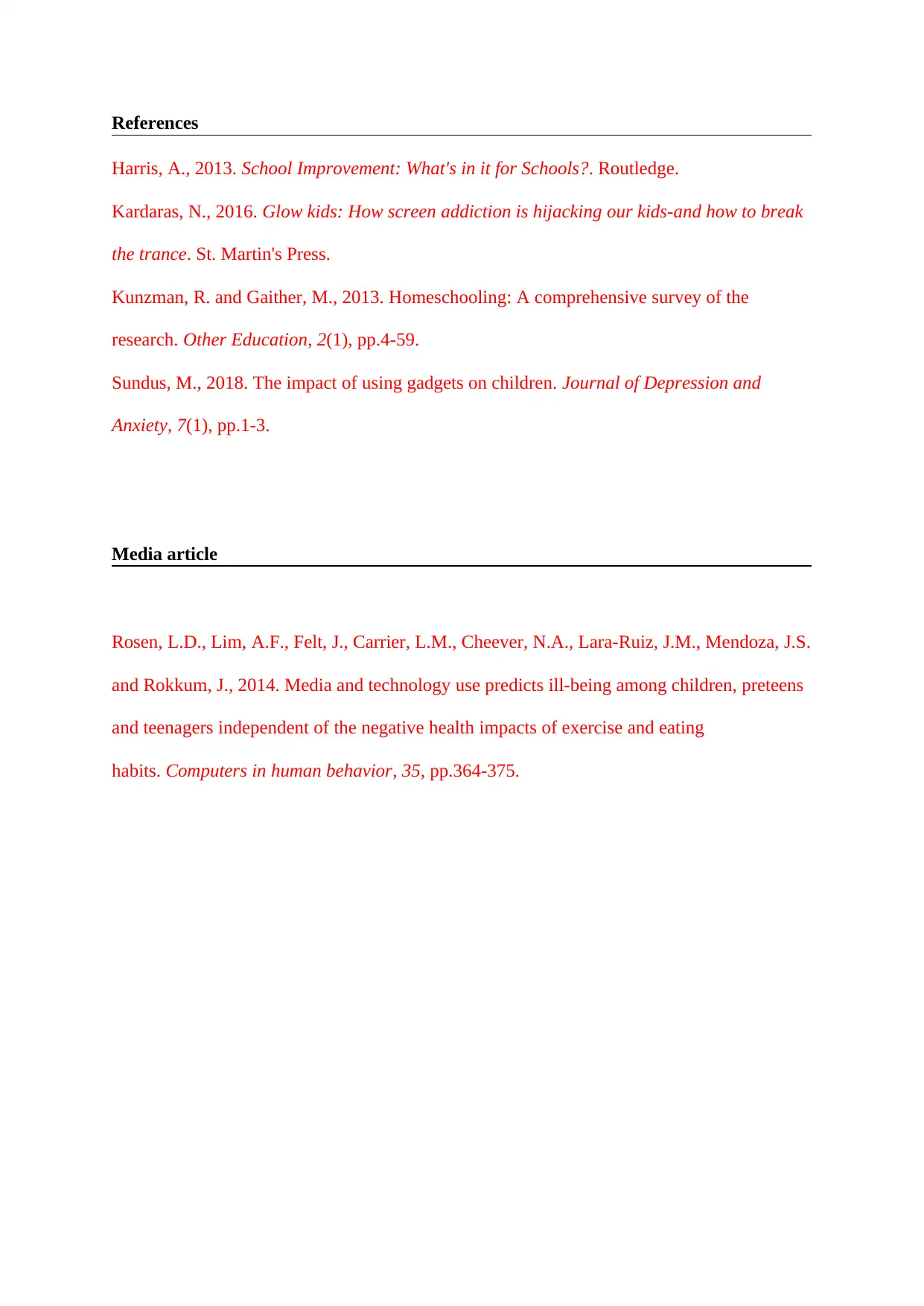
References
Harris, A., 2013. School Improvement: What's in it for Schools?. Routledge.
Kardaras, N., 2016. Glow kids: How screen addiction is hijacking our kids-and how to break
the trance. St. Martin's Press.
Kunzman, R. and Gaither, M., 2013. Homeschooling: A comprehensive survey of the
research. Other Education, 2(1), pp.4-59.
Sundus, M., 2018. The impact of using gadgets on children. Journal of Depression and
Anxiety, 7(1), pp.1-3.
Media article
Rosen, L.D., Lim, A.F., Felt, J., Carrier, L.M., Cheever, N.A., Lara-Ruiz, J.M., Mendoza, J.S.
and Rokkum, J., 2014. Media and technology use predicts ill-being among children, preteens
and teenagers independent of the negative health impacts of exercise and eating
habits. Computers in human behavior, 35, pp.364-375.
Harris, A., 2013. School Improvement: What's in it for Schools?. Routledge.
Kardaras, N., 2016. Glow kids: How screen addiction is hijacking our kids-and how to break
the trance. St. Martin's Press.
Kunzman, R. and Gaither, M., 2013. Homeschooling: A comprehensive survey of the
research. Other Education, 2(1), pp.4-59.
Sundus, M., 2018. The impact of using gadgets on children. Journal of Depression and
Anxiety, 7(1), pp.1-3.
Media article
Rosen, L.D., Lim, A.F., Felt, J., Carrier, L.M., Cheever, N.A., Lara-Ruiz, J.M., Mendoza, J.S.
and Rokkum, J., 2014. Media and technology use predicts ill-being among children, preteens
and teenagers independent of the negative health impacts of exercise and eating
habits. Computers in human behavior, 35, pp.364-375.
1 out of 7
Related Documents
Your All-in-One AI-Powered Toolkit for Academic Success.
+13062052269
info@desklib.com
Available 24*7 on WhatsApp / Email
![[object Object]](/_next/static/media/star-bottom.7253800d.svg)
Unlock your academic potential
Copyright © 2020–2025 A2Z Services. All Rights Reserved. Developed and managed by ZUCOL.





